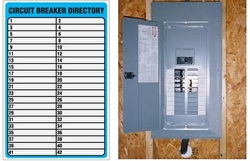|
Stain and seal your deck every 3-4 years. This can help to protect the wood from moisture that may otherwise lead to the deck needing to be replaced entirely.
Before making any repairs to the deck, remove dirt and wood fibers with a pressure washer. If a nail that has worked itself loose from a board, remove the nail. Use a screw to reattach the board. Pressure-treated lumber resists insects and decay, it's still vulnerable to moisture and the sun's rays. To preserve it without changing the color, use clear wood preservative that contains a UV protector, which will bring new life to the surface while protecting it from the elements. If you want to add color, use an exterior stain first. Always use the semi-transparent for the decking area, but try a solid color if you want to highlight railings or banisters.  Painting is an affordable and time saving task of making your home look good as new. Knowing the difference between oil based and water based paints will simplify your choices. Oil based paint
Water based paint
 If you are considering a remodel or renovation these are some steps to remember. If you are considering a remodel or renovation these are some steps to remember.
 It is a task that can be time consuming and tedious, but labeling the circuit breaker box in your home can help alleviate major headaches during remodels and may even save you from catastrophic, yet avoidable accidents. While most electricians and contractors are acutely aware of tragic accidents involving faulty breakers, rarely is there an emphasis to be sure the homeowner has a complete and updated labeling of their breaker boxes. If you are unsure of the breakers that safeguard your home, it is a good idea to have someone to help you go through the house and identify which breakers control which outlets, lights, and other connected entities. If you are unsure of how to proceed or if it seems something you are not comfortable doing, you can call a service technician or handyman service to help. Either way, knowing where the circuit breakers are and how to and control the electrical flow in your home can lead to time saved in the future and may help save much more than that.  A Handy person (or handyman / handy woman) is a person that is competent in, and hired to perform, a wide variety of trade skills and can perform repairs and maintenance jobs around the home. A good handy person should be able to perform tasks that are as easy as changing a light bulb and as difficult as a full bathroom remodel. Most handy person services are set up to perform small to medium sized projects. Some try to stick to the small jobs like changing a door knob or replacing a damaged piece of baseboard trim. Some only do the larger, higher paying jobs like a full kitchen remodel or building a deck. And others focus mainly on commercial maintenance and repairs. The term ‘handyman’ used to refer to the retired gentleman down the street that enjoyed tinkering and could be talked into doing a few minor repairs for a plate of warm cookies. In most places today a handy person is required to be licensed, bonded, and insured. These requirements are good because they help protect the customer when there is an accident caused by the handy person. They also help protect the handy person when the customer does not keep their end of the contract. There is a downside to these requirements though, and that is the cost. Most handy person services in my area charge around $60.00 per hour for their services and many have a minimum charge for small jobs. This may seem like a high price but a handy person does not get to keep all of that like an employee does. A handy person service has to pay all the overhead costs of owning a business, for a wide range of tools necessary to perform a wide range of jobs, for their own vehicle and fuel, and for all the time spent looking at jobs that they may not get. A handy person also has a higher percentage of time spent traveling to and from jobs when the jobs are small. For example, if a handy person has three jobs scheduled for two hours each they may spend one hour or more in travel time for each job. That means for every two hours of work time he is spending one hour in travel time that he doesn't get paid for. Their unpaid travel time equals fifty percent of their paid work time. A contractor doing a larger job may spend one hour of travel time but if they work eight hours then their unpaid travel time is only one eighth of the paid work time. A handy person may have a lot of time during their day that they can't bill for. They have to make that up during the time that they can bill for to make it worth working as a handy person. Some projects around the home can be done easily enough yourself, especially after doing a little research. However, pretty much all projects take a lot longer to DIY, which can sometimes make them cost more. The obvious concern with DIY projects, is that a lot of the time, the results are not as good as they would be from someone who specializes or has done that type of work many times. Some projects are better than others for DIY, for example: interior painting can come out nice DIY, but drywall patching and matching texture is almost impossible to get good results with if you don't have a good amount of experience in those areas.
|
Suggest Blogs
Email blog topic ideas to [email protected] Archives
March 2024
Categories |
 RSS Feed
RSS Feed